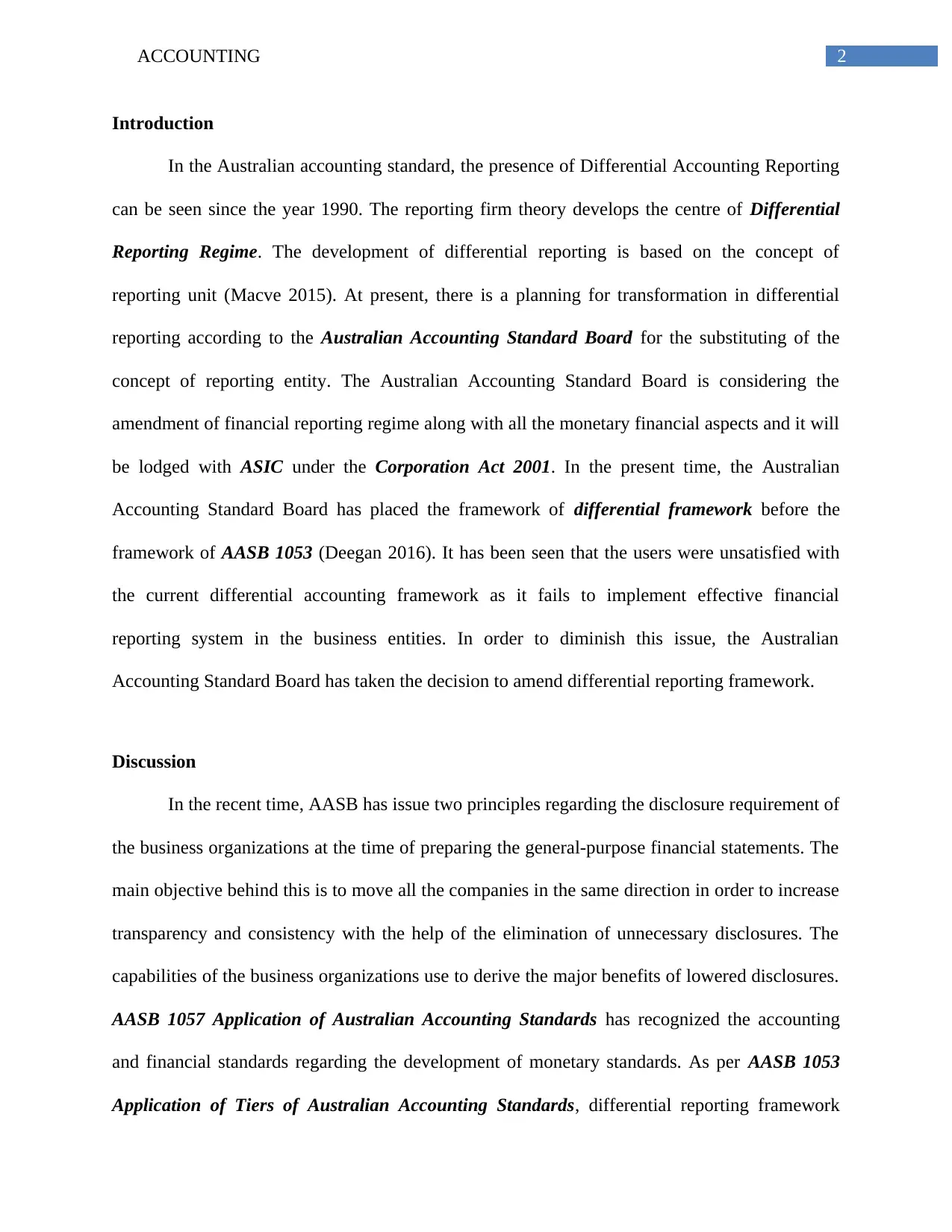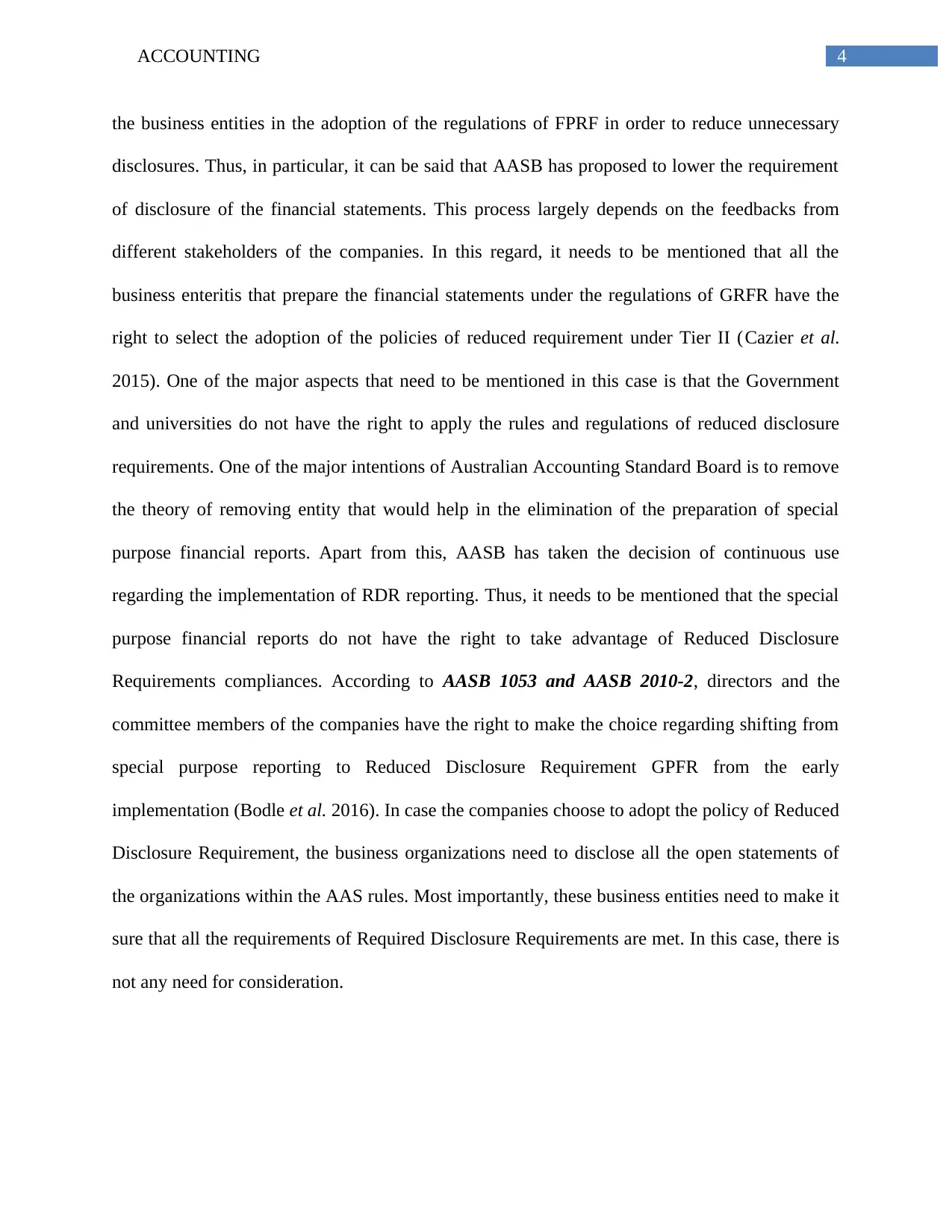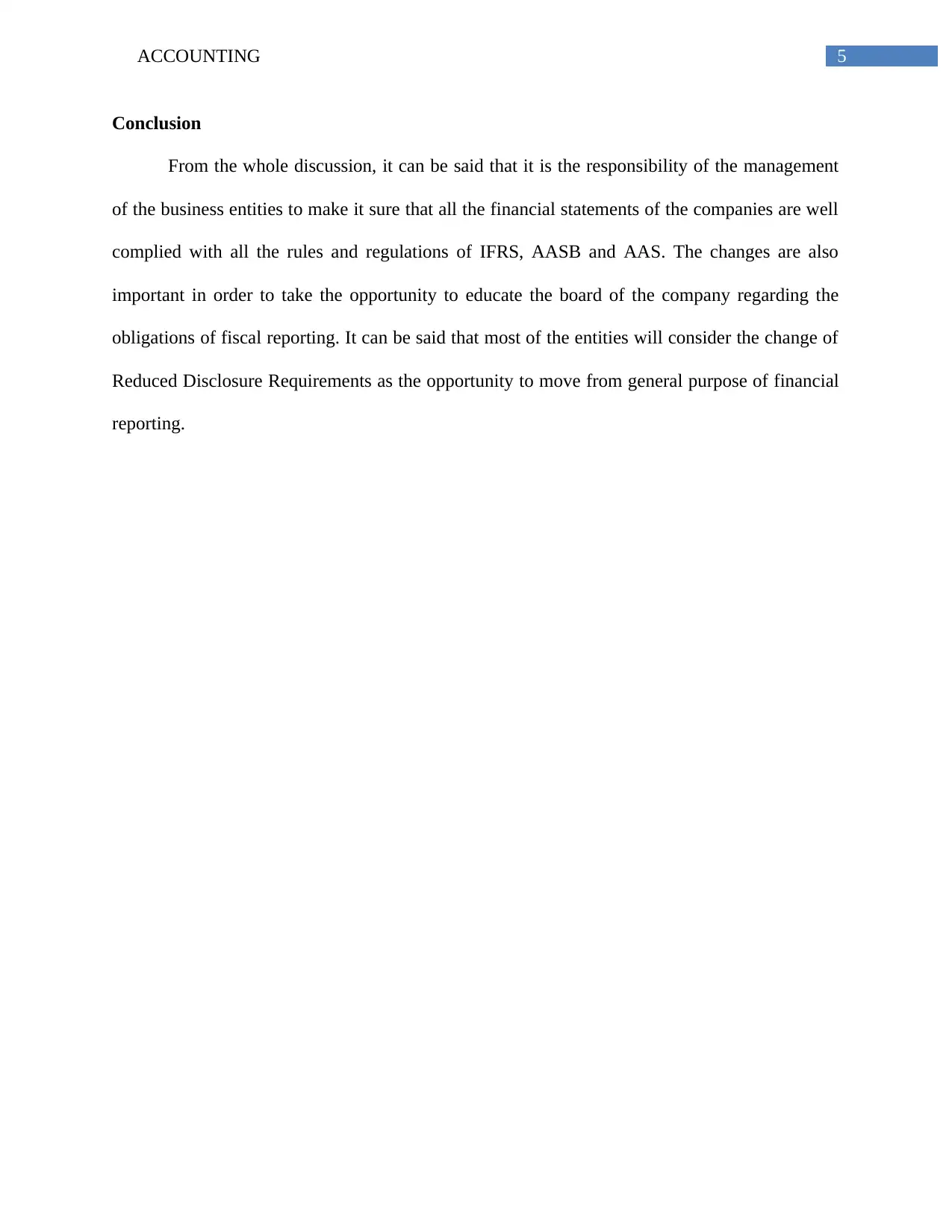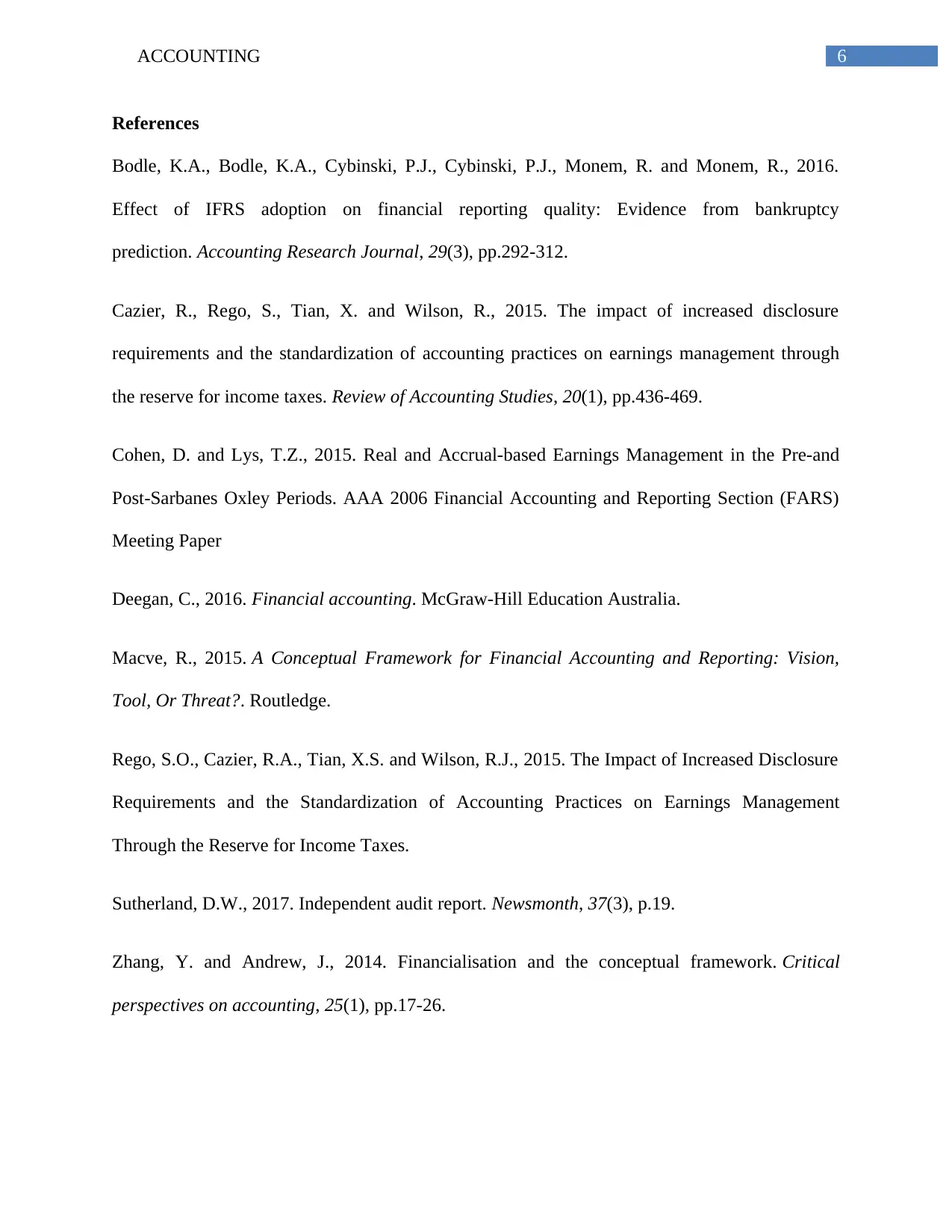Comprehensive Report: Differential Reporting in Australian Accounting
VerifiedAdded on 2020/02/24
|8
|1404
|46
Report
AI Summary
This report provides a comprehensive analysis of differential reporting within the Australian accounting framework, focusing on the evolution and current state of accounting standards in Australia. It examines the role of the Australian Accounting Standards Board (AASB) in shaping financial reporting practices, including the introduction and refinement of differential reporting regimes since 1990. The report explores the two-tiered system (Tier 1 and Tier 2) for financial reporting, outlining the requirements for different types of entities and the implications of adopting International Financial Reporting Standards (IFRS). It also discusses the AASB's efforts to amend the differential reporting framework, including the proposed Reduced Disclosure Requirements (RDR) and their impact on transparency and disclosure. The report references relevant literature, including academic research and professional publications, to support its findings and conclusions regarding the application of these standards.

Running head: ACCOUNTING
Accounting
Name of the Student
Name of the University
Author’s Note
Accounting
Name of the Student
Name of the University
Author’s Note
Paraphrase This Document
Need a fresh take? Get an instant paraphrase of this document with our AI Paraphraser

1ACCOUNTING
Table of Contents
Introduction......................................................................................................................................2
Discussion........................................................................................................................................2
Conclusion.......................................................................................................................................5
References........................................................................................................................................6
Table of Contents
Introduction......................................................................................................................................2
Discussion........................................................................................................................................2
Conclusion.......................................................................................................................................5
References........................................................................................................................................6

2ACCOUNTING
Introduction
In the Australian accounting standard, the presence of Differential Accounting Reporting
can be seen since the year 1990. The reporting firm theory develops the centre of Differential
Reporting Regime. The development of differential reporting is based on the concept of
reporting unit (Macve 2015). At present, there is a planning for transformation in differential
reporting according to the Australian Accounting Standard Board for the substituting of the
concept of reporting entity. The Australian Accounting Standard Board is considering the
amendment of financial reporting regime along with all the monetary financial aspects and it will
be lodged with ASIC under the Corporation Act 2001. In the present time, the Australian
Accounting Standard Board has placed the framework of differential framework before the
framework of AASB 1053 (Deegan 2016). It has been seen that the users were unsatisfied with
the current differential accounting framework as it fails to implement effective financial
reporting system in the business entities. In order to diminish this issue, the Australian
Accounting Standard Board has taken the decision to amend differential reporting framework.
Discussion
In the recent time, AASB has issue two principles regarding the disclosure requirement of
the business organizations at the time of preparing the general-purpose financial statements. The
main objective behind this is to move all the companies in the same direction in order to increase
transparency and consistency with the help of the elimination of unnecessary disclosures. The
capabilities of the business organizations use to derive the major benefits of lowered disclosures.
AASB 1057 Application of Australian Accounting Standards has recognized the accounting
and financial standards regarding the development of monetary standards. As per AASB 1053
Application of Tiers of Australian Accounting Standards, differential reporting framework
Introduction
In the Australian accounting standard, the presence of Differential Accounting Reporting
can be seen since the year 1990. The reporting firm theory develops the centre of Differential
Reporting Regime. The development of differential reporting is based on the concept of
reporting unit (Macve 2015). At present, there is a planning for transformation in differential
reporting according to the Australian Accounting Standard Board for the substituting of the
concept of reporting entity. The Australian Accounting Standard Board is considering the
amendment of financial reporting regime along with all the monetary financial aspects and it will
be lodged with ASIC under the Corporation Act 2001. In the present time, the Australian
Accounting Standard Board has placed the framework of differential framework before the
framework of AASB 1053 (Deegan 2016). It has been seen that the users were unsatisfied with
the current differential accounting framework as it fails to implement effective financial
reporting system in the business entities. In order to diminish this issue, the Australian
Accounting Standard Board has taken the decision to amend differential reporting framework.
Discussion
In the recent time, AASB has issue two principles regarding the disclosure requirement of
the business organizations at the time of preparing the general-purpose financial statements. The
main objective behind this is to move all the companies in the same direction in order to increase
transparency and consistency with the help of the elimination of unnecessary disclosures. The
capabilities of the business organizations use to derive the major benefits of lowered disclosures.
AASB 1057 Application of Australian Accounting Standards has recognized the accounting
and financial standards regarding the development of monetary standards. As per AASB 1053
Application of Tiers of Australian Accounting Standards, differential reporting framework
⊘ This is a preview!⊘
Do you want full access?
Subscribe today to unlock all pages.

Trusted by 1+ million students worldwide

3ACCOUNTING
includes the reporting obligations of two tiers for the preparation of financial statements of the
companies (Zhang and Andrew 2014). Tier 1 helps in the integration of International Financial
Reporting Standards along with the interpretation of financial statements issue by IASB. The
business entities that are bound to disclose their profits are obliged to adopt the regulations of
Tier 1 and thus, they have the responsibility to meet the terms of IFRS. Apart from this, other
for-profit private companies need to comply with the rules and regulations of Tier 1 and thus,
they also needs to follow the regulations of IFRS (Cohen and Lys 2015).
On the other hand, Tier 2 includes the identification and measurement of Tier 1 by
considering the disclosure requirement of Tier 1. In case of Australian Accounting Standard
(AAS), the requirements are same for the Australian companies. All these requirements can be
found in the documents of AAS and this process helps in the integration of not for profit
companies along with the disclosures and regulatory issues. These kinds of regulations help the
companies to comply with the regulations of IFRS (Rego et al. 2015). AASB has reassessed the
rules and standards and it states that the business entities need to incorporate some other relevant
information in the financial reports of the companies according to the disclosure regime. The
stated proposal in Exposure Draft 277 of Reduced Disclosure Requirements for Tier 2, states
that the business entities need to deal with the external reporting concerns that has its own
significance under the regulations of RDR. In this process, the concern of AASB can be seen
regarding the elimination of unnecessary and over detailed disclosures in the financial statements
of the companies. In Australia, some companies can be seen that have the right to adopt the
regulations of RDR instead of the regulations of special purpose reports (Sutherland 2017).
After the implementation of reduced disclosure methods in the organizations, various
stakeholders like supervisors, stakeholders and others believe that this process will be helpful for
includes the reporting obligations of two tiers for the preparation of financial statements of the
companies (Zhang and Andrew 2014). Tier 1 helps in the integration of International Financial
Reporting Standards along with the interpretation of financial statements issue by IASB. The
business entities that are bound to disclose their profits are obliged to adopt the regulations of
Tier 1 and thus, they have the responsibility to meet the terms of IFRS. Apart from this, other
for-profit private companies need to comply with the rules and regulations of Tier 1 and thus,
they also needs to follow the regulations of IFRS (Cohen and Lys 2015).
On the other hand, Tier 2 includes the identification and measurement of Tier 1 by
considering the disclosure requirement of Tier 1. In case of Australian Accounting Standard
(AAS), the requirements are same for the Australian companies. All these requirements can be
found in the documents of AAS and this process helps in the integration of not for profit
companies along with the disclosures and regulatory issues. These kinds of regulations help the
companies to comply with the regulations of IFRS (Rego et al. 2015). AASB has reassessed the
rules and standards and it states that the business entities need to incorporate some other relevant
information in the financial reports of the companies according to the disclosure regime. The
stated proposal in Exposure Draft 277 of Reduced Disclosure Requirements for Tier 2, states
that the business entities need to deal with the external reporting concerns that has its own
significance under the regulations of RDR. In this process, the concern of AASB can be seen
regarding the elimination of unnecessary and over detailed disclosures in the financial statements
of the companies. In Australia, some companies can be seen that have the right to adopt the
regulations of RDR instead of the regulations of special purpose reports (Sutherland 2017).
After the implementation of reduced disclosure methods in the organizations, various
stakeholders like supervisors, stakeholders and others believe that this process will be helpful for
Paraphrase This Document
Need a fresh take? Get an instant paraphrase of this document with our AI Paraphraser

4ACCOUNTING
the business entities in the adoption of the regulations of FPRF in order to reduce unnecessary
disclosures. Thus, in particular, it can be said that AASB has proposed to lower the requirement
of disclosure of the financial statements. This process largely depends on the feedbacks from
different stakeholders of the companies. In this regard, it needs to be mentioned that all the
business enteritis that prepare the financial statements under the regulations of GRFR have the
right to select the adoption of the policies of reduced requirement under Tier II (Cazier et al.
2015). One of the major aspects that need to be mentioned in this case is that the Government
and universities do not have the right to apply the rules and regulations of reduced disclosure
requirements. One of the major intentions of Australian Accounting Standard Board is to remove
the theory of removing entity that would help in the elimination of the preparation of special
purpose financial reports. Apart from this, AASB has taken the decision of continuous use
regarding the implementation of RDR reporting. Thus, it needs to be mentioned that the special
purpose financial reports do not have the right to take advantage of Reduced Disclosure
Requirements compliances. According to AASB 1053 and AASB 2010-2, directors and the
committee members of the companies have the right to make the choice regarding shifting from
special purpose reporting to Reduced Disclosure Requirement GPFR from the early
implementation (Bodle et al. 2016). In case the companies choose to adopt the policy of Reduced
Disclosure Requirement, the business organizations need to disclose all the open statements of
the organizations within the AAS rules. Most importantly, these business entities need to make it
sure that all the requirements of Required Disclosure Requirements are met. In this case, there is
not any need for consideration.
the business entities in the adoption of the regulations of FPRF in order to reduce unnecessary
disclosures. Thus, in particular, it can be said that AASB has proposed to lower the requirement
of disclosure of the financial statements. This process largely depends on the feedbacks from
different stakeholders of the companies. In this regard, it needs to be mentioned that all the
business enteritis that prepare the financial statements under the regulations of GRFR have the
right to select the adoption of the policies of reduced requirement under Tier II (Cazier et al.
2015). One of the major aspects that need to be mentioned in this case is that the Government
and universities do not have the right to apply the rules and regulations of reduced disclosure
requirements. One of the major intentions of Australian Accounting Standard Board is to remove
the theory of removing entity that would help in the elimination of the preparation of special
purpose financial reports. Apart from this, AASB has taken the decision of continuous use
regarding the implementation of RDR reporting. Thus, it needs to be mentioned that the special
purpose financial reports do not have the right to take advantage of Reduced Disclosure
Requirements compliances. According to AASB 1053 and AASB 2010-2, directors and the
committee members of the companies have the right to make the choice regarding shifting from
special purpose reporting to Reduced Disclosure Requirement GPFR from the early
implementation (Bodle et al. 2016). In case the companies choose to adopt the policy of Reduced
Disclosure Requirement, the business organizations need to disclose all the open statements of
the organizations within the AAS rules. Most importantly, these business entities need to make it
sure that all the requirements of Required Disclosure Requirements are met. In this case, there is
not any need for consideration.

5ACCOUNTING
Conclusion
From the whole discussion, it can be said that it is the responsibility of the management
of the business entities to make it sure that all the financial statements of the companies are well
complied with all the rules and regulations of IFRS, AASB and AAS. The changes are also
important in order to take the opportunity to educate the board of the company regarding the
obligations of fiscal reporting. It can be said that most of the entities will consider the change of
Reduced Disclosure Requirements as the opportunity to move from general purpose of financial
reporting.
Conclusion
From the whole discussion, it can be said that it is the responsibility of the management
of the business entities to make it sure that all the financial statements of the companies are well
complied with all the rules and regulations of IFRS, AASB and AAS. The changes are also
important in order to take the opportunity to educate the board of the company regarding the
obligations of fiscal reporting. It can be said that most of the entities will consider the change of
Reduced Disclosure Requirements as the opportunity to move from general purpose of financial
reporting.
⊘ This is a preview!⊘
Do you want full access?
Subscribe today to unlock all pages.

Trusted by 1+ million students worldwide

6ACCOUNTING
References
Bodle, K.A., Bodle, K.A., Cybinski, P.J., Cybinski, P.J., Monem, R. and Monem, R., 2016.
Effect of IFRS adoption on financial reporting quality: Evidence from bankruptcy
prediction. Accounting Research Journal, 29(3), pp.292-312.
Cazier, R., Rego, S., Tian, X. and Wilson, R., 2015. The impact of increased disclosure
requirements and the standardization of accounting practices on earnings management through
the reserve for income taxes. Review of Accounting Studies, 20(1), pp.436-469.
Cohen, D. and Lys, T.Z., 2015. Real and Accrual-based Earnings Management in the Pre-and
Post-Sarbanes Oxley Periods. AAA 2006 Financial Accounting and Reporting Section (FARS)
Meeting Paper
Deegan, C., 2016. Financial accounting. McGraw-Hill Education Australia.
Macve, R., 2015. A Conceptual Framework for Financial Accounting and Reporting: Vision,
Tool, Or Threat?. Routledge.
Rego, S.O., Cazier, R.A., Tian, X.S. and Wilson, R.J., 2015. The Impact of Increased Disclosure
Requirements and the Standardization of Accounting Practices on Earnings Management
Through the Reserve for Income Taxes.
Sutherland, D.W., 2017. Independent audit report. Newsmonth, 37(3), p.19.
Zhang, Y. and Andrew, J., 2014. Financialisation and the conceptual framework. Critical
perspectives on accounting, 25(1), pp.17-26.
References
Bodle, K.A., Bodle, K.A., Cybinski, P.J., Cybinski, P.J., Monem, R. and Monem, R., 2016.
Effect of IFRS adoption on financial reporting quality: Evidence from bankruptcy
prediction. Accounting Research Journal, 29(3), pp.292-312.
Cazier, R., Rego, S., Tian, X. and Wilson, R., 2015. The impact of increased disclosure
requirements and the standardization of accounting practices on earnings management through
the reserve for income taxes. Review of Accounting Studies, 20(1), pp.436-469.
Cohen, D. and Lys, T.Z., 2015. Real and Accrual-based Earnings Management in the Pre-and
Post-Sarbanes Oxley Periods. AAA 2006 Financial Accounting and Reporting Section (FARS)
Meeting Paper
Deegan, C., 2016. Financial accounting. McGraw-Hill Education Australia.
Macve, R., 2015. A Conceptual Framework for Financial Accounting and Reporting: Vision,
Tool, Or Threat?. Routledge.
Rego, S.O., Cazier, R.A., Tian, X.S. and Wilson, R.J., 2015. The Impact of Increased Disclosure
Requirements and the Standardization of Accounting Practices on Earnings Management
Through the Reserve for Income Taxes.
Sutherland, D.W., 2017. Independent audit report. Newsmonth, 37(3), p.19.
Zhang, Y. and Andrew, J., 2014. Financialisation and the conceptual framework. Critical
perspectives on accounting, 25(1), pp.17-26.
Paraphrase This Document
Need a fresh take? Get an instant paraphrase of this document with our AI Paraphraser

7ACCOUNTING
1 out of 8
Related Documents
Your All-in-One AI-Powered Toolkit for Academic Success.
+13062052269
info@desklib.com
Available 24*7 on WhatsApp / Email
![[object Object]](/_next/static/media/star-bottom.7253800d.svg)
Unlock your academic potential
Copyright © 2020–2025 A2Z Services. All Rights Reserved. Developed and managed by ZUCOL.





